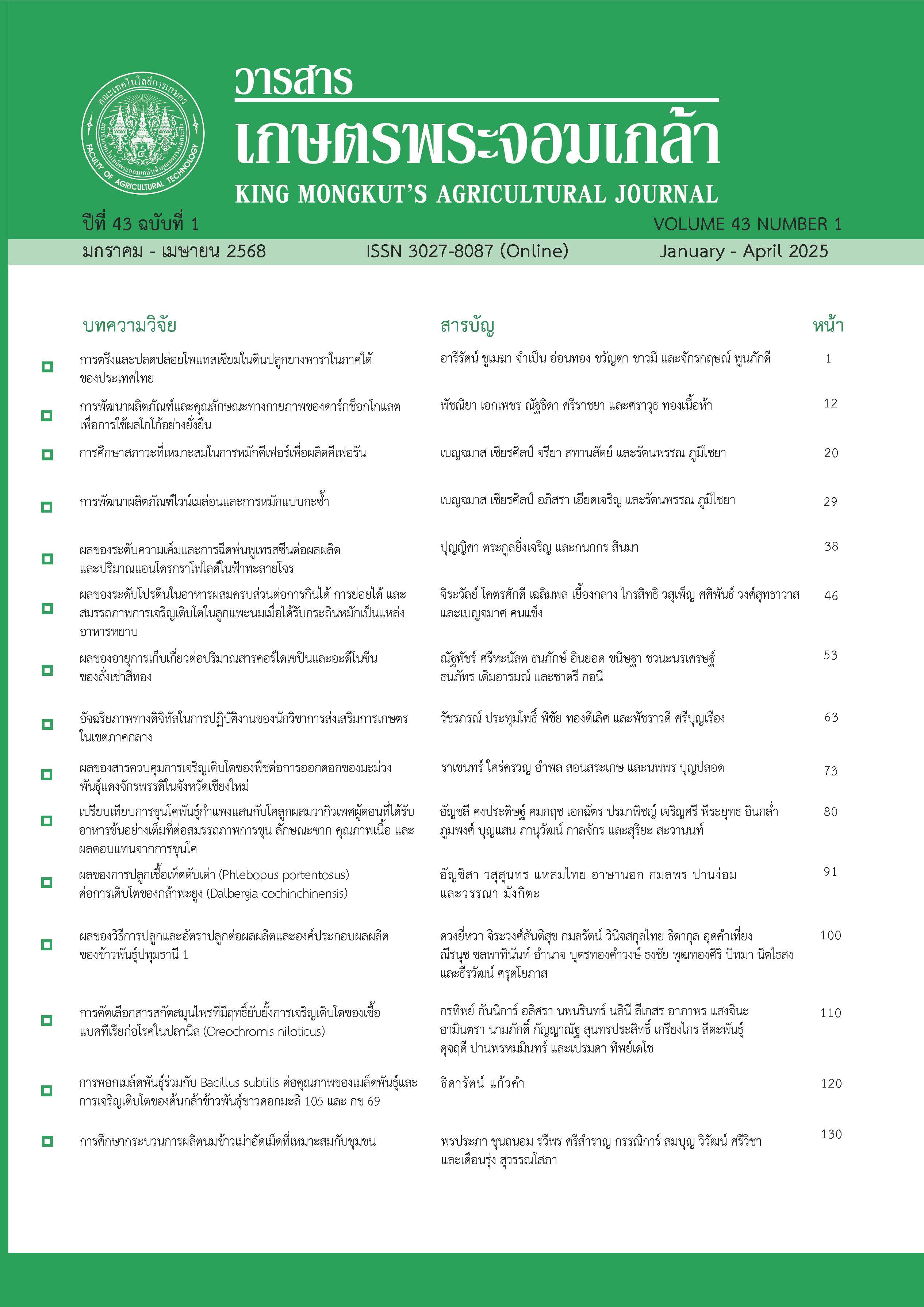Selection of Herb Extracts to Inhibit Pathogenic Bacterial Infection in Nile Tilapia (Oreochromis niloticus)
Main Article Content
Abstract
The objective of this study was to investigate the effect of herbal extracts with inhibitory activity against two pathogenic bacteria in Nile tilapia; Streptococcus agalactiae and Aeromonas hydrophila. The inhibitory activity against pathogenic bacteria was determined by disc diffusion and broth dilution method. The 29 herb (32 herb extracts) species including kaempfer, allium, holy basil, galanga, ginger, white curcuma, turmeric, celery, wildbetal leafbush, climbing wattle, Lao chili wood, lemon grass, green shallot, asiatic pennywort, coriander, culantro, dill, Vietnamese coriander, pepper, kariyat, kaffir lime, leech lime, mullilam, bitter gourd, horse radish tree, tree basil, kitchen mint, Siamese neem tree, shallot, and brown onion were extracted with 95% ethanol (ratio of herbs to solvent equal to 1:6 (w/v)). Galanga showed the highest inhibition of two pathogenic bacteria (A. hydrophila and S. agalactiae) with inhibition zone of 2.80±0.17 and 2.36±0.05 cm., respectively. In this study, the minimum inhibitory concentration (MIC) could not be observed due to the color of the herbs being very dark, obscuring the turbidity of the pathogenic bacteria growth in the test tubes. The result of minimum bactericidal concentration (MBC) against S. agalactiae showed that the extracts of tumeric yielded the best result at 9.7 mg/ml. As for A. hydrophilia, it was found that kaempfer extracts yielded the best MBC value at 156.2 mg/ml. The results of antibacterial testing suggested that turmeric, kaempfer, and white curcuma extracts could be applied in the treatment of bacterial infection in tilapia.
Article Details

This work is licensed under a Creative Commons Attribution-NonCommercial-NoDerivatives 4.0 International License.
King Mongkut's Agricultural Journal
References
Bauer, A. W., Kirby, W. M. M., Serris, J. C., & Turck, M. (1966). Antibiotic susceptibility testing by a standardized single disc method. American Journal of Clinical Pathology, 45(4), 493-496.
Chitmanat, C. (2013). Tilapia diseases. Chiang Mai Veterinary Journal, 11(1), 75-86. (in Thai).
Ciamician, G., & Silber, P. (1897). Zur Kenntnis des curcumins. Berichte der deutschen chemischen Gesellschaft, 30, 192-195. (in German)
Department of Fisheries. (2022). Fisheries Statistics of Thailand 2021. Retrieved from: https://www4.fisheries.go.th/local/index.php/main/view_qr_group/1408/7527. (in Thai).
FAO. (2022). The State of World Fisheries and Aquaculture 2022. Towards Blue Transformation. Rome, FAO. Retrieved from: https://doi.org/10.4060/cc0461en
Harikrishnan, R., Balasundaram, C., & Heo, M. S. (2011). Impact of plant products on innate and adaptive immune system of cultured finfish and shellfish. Aquaculture, 317(1-4), 1-15.
Kamble, M. T., Gallardo, W. G., Yakupitiyage, A., Chavan, B. R., Rusydi, R., & Rahma, A. (2014). Antimicrobial activity of bioactive herbal extracts against Streptococcus agalactiae biotype 2. International Journal of Basis and Applied Biology, 2(3), 152-155.
Kataky, A., & Handique, P. J. (2010). A brief overview on Andrographis paniculata (Burm. f) Nees. A high valued medicinal plant: Boon over synthetic drugs. Asian Journal of Science and Technology, 6(1), 113-118.
Kladkongtug, K. (2019). Efficiency of Crude Extracts from Northern Thai Local Plants on Inhibition of Streptococcus agalactiae and Disease Resistance in Nile tilapia. Master’s Thesis. Chiang Mai University. (in Thai).
Kumar, S., Narain, U., Tripathi, S., & Mirsa, K. (2001). Syntheses of curcumin bioconjugates and study of their antibacterial activities againt ß-lactamases-producing microorganisms. Bioconjugate Chemistry, 12(4), 464-469.
Lutomski, J., Kedzia, B., & Debska, W. (1974). Effect of an alcohol extract and active ingredients from Curcuma longa on bacteria and fungi. Plant Medica, 26(5), 9-19.
Nithikulworawong, N. (2012). Efficacy of Bauhinia sirindhorniae on resistance to against Streptococcus agalactiae in Nile tilapia (Oreochromis niloticus). KKU Research Journal, 17(5), 715-724. (in Thai).
Nonwachai, T., & Duangkaew, D. (2016). Effect of Thai herbs extracted on growth inhibition of Aeromonas hydrophila. Khon Kaen Agriculture Journal, 44(Suppl.1), 124-129. (in Thai).
Pachanawan, A. (2012). Potential of Thai Herbs and their Extracts as Alternatives to Antibiotics for Controlling Streptococcus agalactiae and Aeromonas hydrophila Infections in Nile tilapia (Oreochromis niloticus Linn.). Doctoral Thesis. Ubon Ratchathani University. (in Thai).
Pojanaukij, N., & Kajorncheappunngam, S. (2010). Comparison of antimicrobial activity of mangosteen crude, turmeric and gotu kola extract. Naresuan University Journal, 18(1), 1-9. (in Thai).
Potiwong, C., Suwan, C., Noimoon, P., Yawichai, P., Jitmanowan, S., & Chitmanat, C. (2020). Effects of medicinal plants on fish immunity and its growth performances. Burapha Science Journal, 25(2), 595-616. (in Thai).
Purseglove, J. W., Brown, E. G., Green, C. L., & Robbins, S. R. J. (1981). Spices. Longman.
Rattanachaikunsopon, P., & Phumkhachorn, P. (2010). Use of herbs as prophylactic and therapeutic agents in fish. Journal of Science and Technology, Ubon Ratchathani University, 12(4), 63-71. (in Thai).
Shankar, T. N. B., & Murthy, V. S. (1978). Effect of turmeric (Curcuma longa) on the growth of some intestinal bacteria in vitro. Journal of Food Science and Technology, 15(4), 152-153.
Shankar, T. N. B., & Murthy, V. S. (1979). Effect of turmeric (Curcuma longa) fractions on the growth of some intestinal and pathogenic bacteria in vitro. Indian Journal of Experimental Biology, 17(12), 1363-1366.
Siramon, P., & Waeonukul, R. (2021). Chemical composition and antibacterial activities of rhizome extract from Curcuma aromatica Salisb. YRU Journal of Science and Technology, 6(2), 118-125. (in Thai).
Srisayam, M., Jooduang, J., Srisopa, A., Keerin, P., & Sangthong, S. (2018). Chemical composition and antibacterial activity of essential oils from three curcuma species in Thailand. Life Sciences and Environment Journal, 19(2), 222-233. (in Thai).
Vanichkul, K. (2010). Role of Turmeric (Curcuma longa Linn.) and Creat (Andrographis paniculata Wall. Ex Nees) Extract on Immunity of Aquatic Animals and their Activities on the Control of Pathogenic Bacteria. Doctoral Thesis. Kasetsart University. (in Thai).
Von, J., Lutomski, B., & Kedzia, W. D. (1974). Effect of an alcohol extract and active ingredients from Curcuma longa on bacteria and fungi. Plant Medica, 26(1), 9-19.


